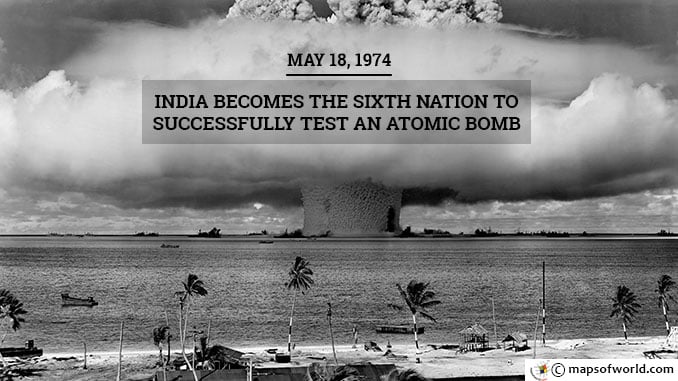On May 18, 1974, at 8.05 am local time, the Indian Army conducted the first nuclear weapon explosion by the country. The detonation at Pokhran Test Range in the Pokhran region of Rajasthan state in India was codenamed Smiling Buddha, though referred to by the Indian Ministry of External Affairs (MoEA) as Pokhran- I. The test was overseen by senior personnel of the Indian Army. With the success of the test, India became the sixth nation and the first non-permanent United Nations member to have tested a nuclear missile. Though the MoEA designated Pokhran-I a peaceful nuclear test, it was part of India’s nuclear armament program and is estimated to have had a weapon yield of up to 8 kilotons of TNT. The US became the first nation to conduct nuclear weapon tests in 1945 with the operation codenamed Trinity. Russia was not too far to follow when RDS – 1 was undertaken in 1949. United Kingdom was the next nation to test nuclear warheads in 1952 with Operation Hurricane having been declared a success. In 1960, with Gerboise Blue, France joined the league of nuclear nations. Within the next four years, in 1964, China joined in with the test codenamed 596. Even as early as 1968, India had refused to be a signatory to the nuclear Non-Proliferation Treaty, or NPT. India doggedly maintained that the treaty was discriminatory. The terms of the NPT allowed the Nuclear Weapons States, nations which had tested nuclear weapons before January 1967 to retain their nuclear arsenal, even while foreclosing the option of acquiring one to all other nations. India remained keen on defending its right to develop and test nuclear weapons. While touring the Bhabha Atomic Research Center (BARC) on September 7, 1972 India’s then Prime Minister Indira Gandhi gave the scientists a verbal go-ahead to manufacture a nuclear device designed by the center and to prepare it for testing. Just as Indian nuclear scientists set out to construct the device, the preparation of a suitable test location also commenced. In the development of the device, called “Peaceful Nuclear Explosive” (PNE) or Smiling Buddha, India did not maintain records. The decisions made in the development and testing process went largely unrecorded. The choice was intentional and secrecy was considered top priority. Following the success of the test in Pokhran, documentation for the process was completed depending largely on oral records of those involved. Smiling Buddha was developed by a team of elite nuclear scientists in India. Raja Ramanna, the director of BARC himself led the project. Ramanna’s closest associate in the program was the director of the Defense Research Development Organization (DRDO), Dr. Basanti Dulal Nag Chaudhuri. Dr. Nag Chaudhuri had also been functioning as the science advisor to the Indian Ministry of Defense and had worked on defining the explosive system development in the country. Ramanna was assisted by P.K. Iyengar, another leading national nuclear scientist. R. Chidambaram led the nuclear system design team. Dr. Nagapattinam Sambasiva Venkatesan lead the DRDO Terminal Ballistics Research Laboratory (TBRL) in the Union Territory of Chandigarh to develop the high explosive implosion system of Smiling Buddha. India’s test did cause concern in the international community. The United States led the nations seeking to consolidate global nuclear non-proliferation laws. India was barred from any multilateral trade involving nuclear and other sensitive technologies. Through the 1990s, India was debarred from being involved with other nations in any form of nuclear trade or collaboration. With Operation Shakti (Pokhran –II) on May 11, 1998, India declared its unyielding stance with regard to building up a nuclear arsenal. Vociferous criticism broke out all around. With the U.S. staunchly opposing the tests, the G8 nations imposed sanctions and blocked financial aid to India from leading global financial institutions. India faced much resistance at the UN and it was declared that the nation would not be granted the status of a Nuclear Weapons State. It looked like India would soon become a pariah in the global nuclear scenario. The 123 Agreement between the United States and India, known as the US-India Civil Nuclear Agreement in 2005 came as an unexpected turnaround in events. The U.S. decided to end hostilities and ally itself with India by granting the south Asian republic the right to civil nuclear trade. U.S. recognition as a “responsible nuclear state” gave India a special status in the global scenario. New Delhi now started to enjoy “the same benefits and advantages” as other states with “advanced nuclear technology”. Despite maintaining a stance against the NPT, India gained a status equivalent to the Nuclear Weapons States thus creating an unprecedented exception. Also On This Day: 1652 – Rhode Island passes the first law making slavery illegal. 1792 – Russian troops invade Poland. 1804 – Napoleon Bonaparte is proclaimed emperor by the French Senate. 1951 – The United Nations moves its headquarters to New York City.
May 18 1974 – India Becomes the Sixth Nation to Successfully Test an Atomic Bomb
On May 18, 1974, at 8.05 am local time, the Indian Army conducted the first nuclear weapon explosion by the country. The detonation at Pokhran Test Range in the Pokhran…
438
